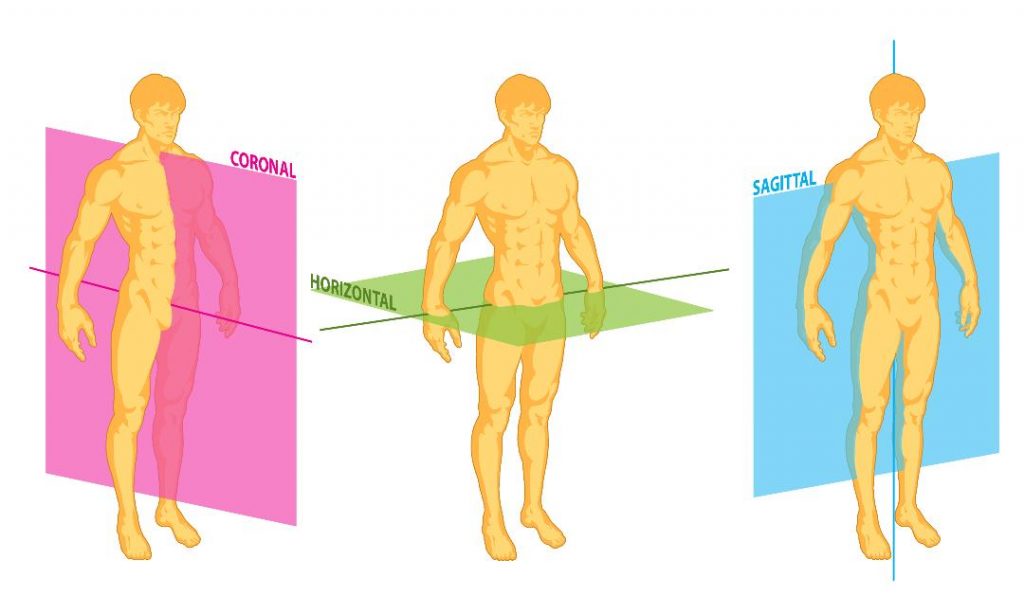The body interacts with a three-dimensional environment (on three planes), but often we restrict our bodies by only moving in one dimension. Purposely engaging a full range of movement with conscious breath can infuse the body with much-needed, energizing oxygen.
PART ONE: Learn to Move and Breathe Front-to-Back (Sagittal Plane)
Unconscious Patterns
Our days are full of moving to sit, stand, drive, and walk. But it doesn’t occur to us that we move in repetitive patterns, and therefore limit our vitality.
If any movement pattern goes unused, the brain will prune away neural connections that support it. In short, if we don’t use it, we lose it. Unused movements can create compensatory movements that become habits. These create a “new normal” in the brain. Healthcare professionals often see this translate to osteoarthritis, degenerative disease, bursitis, tendonitis, and chronic pain throughout the body.
Move Around!
Although it may seem counterintuitive, the secret to a little more energy lies in a little more physical movement. And not just any movement. Conscious movement or paying attention and focusing movement in a specific direction is important. The estimated 360 skeletal joints of our body are meant to move along three dimensional planes of movement: forward and backward (sagittal plane), side to side (frontal plane), and right and left (transverse plane).
 As an adult, most of our movement patterns are in the sagittal plane. See how all of these movements are front to back:
As an adult, most of our movement patterns are in the sagittal plane. See how all of these movements are front to back:
● Standing up from a chair
● Rising off the toilet
● Pushing /pulling doors
● Picking items off the floor
● Pulling food out of the refrigerator
● Walking up or down stairs
● Bending elbows to carry bags of groceries
Observe people around you while they perform routine functional movements from a side view. Notice how their trunk, arms and legs barely move past neutral or upright. You’ll see how we often neglect half the sagittal plane, the parts of our self that move backward.
Some Body Parts Are Built for the Sagittal Plane
The lumbar spine skeletal architecture is designed to excel by safely move front to back. That’s a good thing since we are bending forward and straightening back up so much throughout our day!
The shoulder blade and the pelvis have a two-part skeletal design. At one end are sockets and shaped like ice cream scoops. They receive the ball-shaped end of the arms and legs. The other end is like a smooth curved flat plate. Acting together, the joints are designed to slide and glide, “carrying” our arms and legs forward and backward.
Try A Breath Exercise
A peculiar event happens when we draw our attention to our breath…we spontaneously notice a deeper inhale. That’s good because rarely do we reach our lung capacity and level of oxygenation that could help turn on our alert or wake centers located in the base of our brain – the reticular activating system.
Consciously perform this forward and backward range of motion, while noticing your breath. The result should be a fuller, deeper breath and potential for the breastbone and ribs to lift out of a late afternoon slump. Try these guided steps to do this:
1) “Sniffing” your inhale. From a seated position, try three or four sniffs per inhale. Hold your breath for a count of two, and then notice the long exhale that comes next . Repeat 2-3 more times. Can you sense both the front and back of the rib basket or cage moving in the sagittal plane?
2) Add backward movement. Stand with feet comfortably close together. Lift the left heel and arch of the foot up from the ground so only the ball of the foot remains on the ground. Feel how your pelvis shifted to the right and your right foot sunk deeper into the ground.
3) Lift the right arm up and next to (parallel) to the ear. Keep the right elbow straight. Without bending the neck back much, let the head and eyes follow the right hand as your carry the right arm backward. The lower jaw can disengage from the top teeth and hang, let the chest lift. Can you sense an ease of spinal movement, or lack of it? Is there a little more “incurve” of the low back?
4) Tune into your spine as it moves through the sagittal plane, arcing slightly back as you allow the pelvis to shift slightly forward over the right toes. Pause and return to the beginning.
5) Repeat several times. Notice your breath. Do you hold it? Do you inhale as you arc backward in the sagittal plane? Do you exhale? Can all three options be available? Which option feels the best?
6) Repeat the movement pattern on the other side, changing the feet and arm positions. You might notice that on one side, the arc is smoother and easier. This will reveal which hip joint can move back in the sagittal plane or extend easier. This backward motion is also key for avoiding hip replacements, key for improving head turning and looking over the shoulder and key in balance recovery or preventing near falls.
Enjoy a full, deep breath, and come back next month to discover how to move and breathe in the frontal plane!
